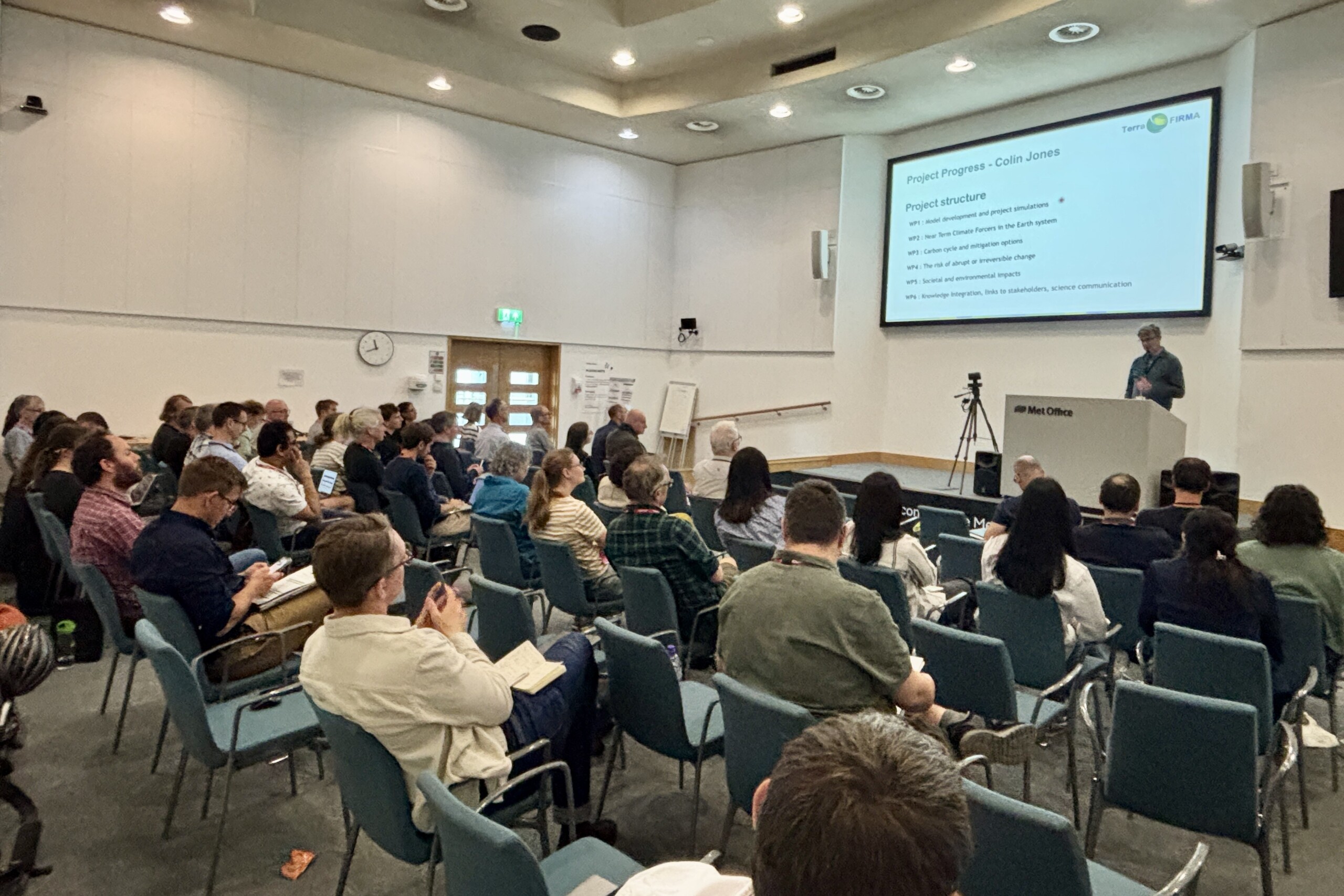News
TerraFIRMA Update on Progress
Colin Jones1 & TerraFIRMA Work Package Leads
1National Centre for Atmospheric Science

Progress is being made in a number of areas across this multi-centre partnership. Some of our recent highlights are below.
WP1: Model development, simulations and data required in the project
A documentation paper for the latest UKESM model release (UKESM1.1) is in review and should be accepted by the end of 2022. A version of UKESM1.1 has been developed that includes interactive Greenland and Antarctic ice sheets (UKESM1.1-ice). This version will be used for a first set of global warming overshoot experiments.
Warming overshoot experiment protocols have been designed and tested with (i) UKESM1.1 run in CO2 concentration driven mode, with overshoots designed around 1% transient CO2 increases, followed by, for example, fixed atmospheric CO2 concentrations at 2 x pre-industrial values and then decreases of atmospheric CO2 (at both –1% and –0.5% rates) back to pre-industrial values. Different lengths and magnitude of overshoot are being tested. (ii) Using UKESM1.1 run in CO2-emission mode following a 10GtC/yr linear emissions increase from pre-industrial conditions. Anthropogenic emissions are set to zero when the model’s global mean surface air temperature (GSAT) reaches values of 1.5, 2, 3 and 4oC above pre-industrial values. This allows GSAT to stabilize and a zero emission pathway is followed for different lengths of time, before transitioning into a negative emission pathway that removes CO2 from the atmosphere.
Following an online workshop to discuss what type of simulations are required to investigate the risk of abrupt change in climate phenomena, it has been decided that a first set of idealized overshoot experiments will use option (ii) using UKESM1.1-ice in CO2 emission mode.
WP2: Near-term climate forcers in the Earth system and their potential for climate mitigation
A number of papers have been published in this work package including: Folberth et al (2022), describing the UKESM1 methane emissions capability; Staniaszek et al. (2022), quantifying climate, air quality and human health impacts of methane emissions; and Turnock et al. (2022), assessing the climate-air quality co-benefits of future Near Term Climate Forcer mitigation. Work is ongoing to assess the COP26 Methane pledges (reduction in emissions by 30% relative to present-day) using the UKESM1.0 methane emission-driven model.
RAMIP (Regional Aerosol emissions MIP) will assess the impact of future aerosol and aerosol-precursor emission reductions over the Indian sub-continent, East Asia and Africa on future climate and air quality. RAMIP is being led by Laura Wilcox at NCAS-Reading and an experiment protocol has recently been developed and is documented in (Wilcox et al. 2022). The first set of RAMIP simulations have been performed with UKESM1.0. RAMIP presently includes 6 ESMs from Europe, North America and Asia.
WP3: Carbon cycle feedbacks in the Earth System and the potential for climate mitigation
This Work Package combines models and observations to constrain key uncertain carbon cycle processes in UKESM models. It examines the efficacy of land-based mitigation strategies, assessing the role forests play in climate change mitigation and the degree of permanency of carbon uptake by the terrestrial and marine sinks. A new avenue of research has recently started using UKESM1.0 to assess the mitigation potential from enhanced ocean alkalinity and its impact of carbon uptake.
A paper on ‘Global warming carbon allocation’ has been submitted. New diagnostics for the BGCVal2 analysis package were developed and BGCVal2 has been further developed to make it more user friendly.
Work is progressing to get the JULES model with atmospheric deposition developments into the UM (Unified Model) and UKCA (UK Chemistry & Aerosols) trunks. Various machine learning methods have been applied to JULES and CMIP models (including UKESM) to emulate GPP (Gross Primary Production) and understand how factors controlling GPP vary across models.
WP4: Rapid or irreversible change in the Earth system
Work Package 4 investigates the risk of triggering abrupt change in key Earth system phenomena if global warming exceeds and/or stabilizes at a range of global warming targets (so-called tipping points). Our focus is on the Antarctic ice sheet, marine ecosystems and tropical forests and will include an assessment of the potential reversibility of any triggered abrupt changes.
Ice: Progress is being made in generating estimates of grounding line evolution in key sectors of Antarctica. Required datasets have been collected (CryoSat-2 ice sheet elevation data) and code development is underway. Progress has been made on the coupled NEMO-BISICLES circum-Antarctic regional model. A paper describing the UKESM1-ice projection ensemble has been completed. Work has progressed on a manuscript investigating the use of a stand-alone snow scheme and detailed wind dynamics to simulate an extreme surface melt event over the Ross Ice Shelf. The technical principles of moving land-sea mask and ice shelf area in UKESM2-ice has been established.
Ocean: High resolution (1/12°) ocean projections forced by UKESM1 SSP370 data are complete. Preliminary analysis of key NAB (North Atlantic bloom) characteristics and their future evolution in the high-resolution ocean run and UKESM1 have been performed, highlighting the collapse of ocean convection in the Subpolar Gyre as a key mechanism (and potentially a tipping point) behind the NAB collapse.
Forests: A working version of the offline INFERNO fire model- has been developed and will be used to optimize uncertain parameters controlling fire occurrence and fire-vegetation interactions. The INFERNO fire model is now technically running in UKESM, though a dry bias in the western Amazon means we have too much fire and associated forest loss. Thermal acclimation is also working with dynamic vegetation, though with some important differences in vegetation cover and carbon uptake in central Amazon that we are trying to understand.
WP5: The societal and environmental impacts of global change
Work Package 5 investigates five socio-environmental impacts arising from climate change: (i) water resources, flooding and landslides, (ii) climate and air quality interactions, (iii) wildfires, (iv) marine ecosystems and (v) global sea level. Three primary regions are targeted: (i) sub-Saharan Africa, (ii) the south Asian monsoon (land and ocean) and (iii) the North Atlantic and the UK.
A series of pilot studies on groundwater response to climate have been developed for Africa and South Asia, with partners and key observational datasets collated. A first cut groundwater model for Africa has been developed in tandem with Hydro-JULES, and progress has been made in incorporating groundwater and canal/irrigation interaction in the land surface model for the Ganges. Fire results from JULES-ES-INFERNO have been submitted to ISIMIP3a, and ISIMIP results are being used in a post-process coupling to the ConFire attribution method.
On air quality we have engaged with a number of stakeholders including Defra, UKHSA and UK academics to identify key interests and requirements with respect to UKESM simulations that address both future climate and air quality.
We are addressing the question of whether climate projections from regional ERSEM-NEMO tell a significantly different story to the UKESM model. We have developed a test case using a macrophyte model and made preliminary projections based on the regional model. At the global scale, we have finalised diagnostic algorithms for characterizing marine hydrological and biogeochemical (BGC) extremes (e.g. marine heatwaves, anomalous blooms, acidification, deoxygenation).
A preliminary methodology for upscaling the JULES-OGGM (glacier model) to the global scale has been established and required data is being assembled. We are consulting with the MAGICC impacts modelling team on the possibility of using TerraFIRMA GMSLR information in their system for producing future scenarios
WP6: Knowledge integration and dissemination
Work Package 6 is a central project activity, building relationships with stakeholders and with the broader UK research community. It aims to integrate science across the project, ensuring two-way communication with policymakers and the public and a suitable level of interaction between project tasks. WP6 will also ensure TerraFIRMA collaborates with the other NERC multi-centre projects funded for the 2022 to 2027 period.
The initial focus of this WP was in setting up governance and project management, including the Science Steering Group, Advisory Board and the Early Career Researcher network.
The first TerraFIRMA General Assembly (GA) was held in May 2022 at UKCEH Wallingford with around 50 people in-person and another 20-30 people online. Stakeholders from the European Space Agency (ESA), UK Health Security Agency (UKHSA), Climate Change Committee (CCC) and the Department for Business, Education, Industrial Strategy (BEIS) joined the meeting. Presentations included setting out the programme, development of HadGEM3-GC5 and UKESM2, and the relationship with other LTSM projects, followed by breakout groups to plan the work packages in more detail.
A TerraFIRMA web page is included in the UKESM web site, pending a new TerraFIRMA site being set up. Twitter account @TerraFIRMAclim8 is active.
A major public engagement event took place at New Scientist Live in London in October, involving colleagues from across TerraFIRMA, the Met Office and in collaboration with European colleagues from the ESM2025 project. See the article on the public engagement for further details.


